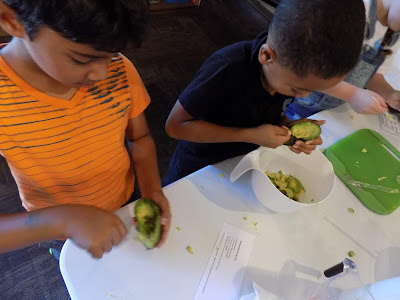I had printed ahead of time three different recipes for guacamole (I'll add them soon.) All the ingredients and tools were laid out on one side of the table. Each team was given a mixing bowl. I cut the avocados in half ahead of time, and made a huge sign that said "REMOVE AVOCADO PITS WITH A SPOON!!" and emphasized to the adults not to let the kids use knives to take out the pits. It is really easy to injure yourself doing that.
Each team's recipe was slightly different, but they were all normal guacamole recipes. I asked the adults to encourage the children to read the recipes and measure things, in order to sneak a bit of math into the activity, even though it doesn't really matter if you use 1/2 tablespoon of garlic or a whole tablespoon.
I had told the kids they could use the knives if they felt comfortable doing so, and if they could do so safely. If they couldn't, they could ask an adult to cut things for them.
During each team's rotation, the kids did a great job dividing up the responsibilities, and not being too grabby with things. When all the teams finished, we had a taste test. Before doing the tasting, I read each team's list of ingredients out loud so kids had an idea what they might be tasting.
Each student got a plate with some tortilla chips, and made a line. I put a small scoop of team 1's guacamole on each plate. When everyone ate up #1, they lined up again for #2. And after that, they lined up for #3. I wrote on the white board three headings: Team 1, Team 2, Team 3, and each kid came up and marked their vote for favorite guacamole. I had copies of the recipes available for them to take home if they wanted.
Kids loved this activity! Some said they couldn't wait to go home and make guacamole. Almost all of them enjoyed the 'cooking' element, even the kids that hate guacamole. And they really did almost the whole thing themselves.
Recipes:
Guacamole
Recipe #1:
·
2 ripe avocados-
·
1 Tablespoon chopped
onion
·
½ Tablespoon chopped
garlic
·
5 tomatoes, chopped
·
1 Tablespoon lime
juice (or juice of 1 fresh lime)
Put all ingredients in
mixing bowl. Mash until all ingredients
are mixed together.
Guacamole
Recipe #2:
·
2 ripe avocados
·
2 Tablespoons Sour
Cream
·
5 Tomatoes, chopped
·
½ Tablespoon Cilantro
·
3 shakes of garlic
salt
·
1 Tablespoon lime
juice
Put all ingredients in
mixing bowl. Mash until all ingredients
are mixed together.
Guacamole
Recipe #3:
·
2 ripe avocados
·
2 Tablespoons salsa
·
½ Tablespoon chopped
garlic
·
1 Tablespoon lime
juice
·
½ Tablespoon cilantro
Put all ingredients in
mixing bowl. Mash until all ingredients
are mixed together.





